机器学习和可解释的人工智能揭示了与头颈部鳞状细胞癌患者生存相关的microrna
IF 2.6
4区 生物学
Q2 BIOLOGY
引用次数: 0
摘要
失调的microRNAs (miRNAs)在癌症的发生和转移中起着重要的作用。在文献中,mirna已被用于人工智能对不同类型癌症的生存预测。尽管人工智能对癌症的诊断和预后预测很有用,但将其纳入医学领域的一个主要批评是,它本质上是一个机械上无法解释的不透明的“黑盒子”,因此,在癌症诊断和预后决策方面,它可能不具备在临床环境中采用所需的问责制、透明度和可靠性。因此,有必要开发智能模型来解释他们的预测,以便临床医生可以可靠地使用。据报道,失调的mirna会导致癌症转移,因此它们可能在患者的生存中发挥作用。因此,有必要开发基于ML的技术,可以自动指示与患者生存相关的特定mirna。在本研究中,利用miRNA序列和临床数据集,开发了基于机器学习和可解释人工智能(XAI)的模型,用于头颈部鳞状细胞癌(HNSC)患者的生存预测。miRNAs数据集包含485例HNSC患者数据,临床数据集包含528例HNSC患者数据。提出的基于XAI的模型通过显示与患者生存相关的特定miRNA序列来解释其预测,以证明临床医生用于治疗决策的可靠性。在这项研究中,研究表明,可解释的机器学习可以提供关于模型如何进行预测的明确知识,这对于在肿瘤学和医疗保健领域增加信任和采用创新的机器学习技术是必要的。本文章由计算机程序翻译,如有差异,请以英文原文为准。
Machine learning and explainable artificial intelligence reveals the MicroRNAs associated with survival of head and neck squamous cell carcinoma patients
Dysregulated microRNAs (miRNAs) play a significant role in cancer development and metastasis. In literature, miRNAs have been used for the survival prediction of different types of cancers using AI. Although AI is useful for diagnosis and prognosis prediction of cancer, however, a major criticism of incorporating it into medical fields is that it is essentially a mechanistically uninterpretable opaque “black box”, and hence it may not have the required level of accountability, transparency, and reliability in decisions of cancer diagnosis and prognosis for their adoption in clinical settings. Therefore, there is need to develop intelligent models which may explain their prediction so that they may be reliably used by the clinicians. As dysregulated miRNAs are reported to cause cancer metastasis hence, they can play role in survival of patient. Therefore, there is needed to develop ML based techniques which may automatically indicate specific miRNAs involved in survival of patients. In this research, Machine Learning and Explainable AI (XAI) based models have been developed for survival prediction of Head and Neck Squamous Cell Carcinoma (HNSC) patients using miRNA sequences and clinical datasets. miRNAs dataset contains the data of 485 HNSC patients and clinical dataset contains data of 528 patients. The proposed XAI based model explains its prediction by showing the specific miRNA sequences involved in survival of the patients to demonstrate its reliability to be used by clinicians for therapeutic decisions. In this study, it has been shown that explainable ML can provide explicit knowledge of how models make their predictions, which is necessary for increasing the trust and adoption of innovative ML techniques in oncology and healthcare.
求助全文
通过发布文献求助,成功后即可免费获取论文全文。
去求助
来源期刊

Computational Biology and Chemistry
生物-计算机:跨学科应用
CiteScore
6.10
自引率
3.20%
发文量
142
审稿时长
24 days
期刊介绍:
Computational Biology and Chemistry publishes original research papers and review articles in all areas of computational life sciences. High quality research contributions with a major computational component in the areas of nucleic acid and protein sequence research, molecular evolution, molecular genetics (functional genomics and proteomics), theory and practice of either biology-specific or chemical-biology-specific modeling, and structural biology of nucleic acids and proteins are particularly welcome. Exceptionally high quality research work in bioinformatics, systems biology, ecology, computational pharmacology, metabolism, biomedical engineering, epidemiology, and statistical genetics will also be considered.
Given their inherent uncertainty, protein modeling and molecular docking studies should be thoroughly validated. In the absence of experimental results for validation, the use of molecular dynamics simulations along with detailed free energy calculations, for example, should be used as complementary techniques to support the major conclusions. Submissions of premature modeling exercises without additional biological insights will not be considered.
Review articles will generally be commissioned by the editors and should not be submitted to the journal without explicit invitation. However prospective authors are welcome to send a brief (one to three pages) synopsis, which will be evaluated by the editors.
 求助内容:
求助内容: 应助结果提醒方式:
应助结果提醒方式:


